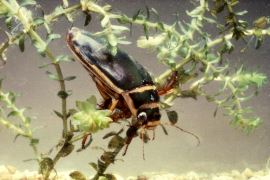 Water levels in the ponds and streams on Lundy are governed by rainfall with several drying up during periods of drought and many temporary water bodies appearing during periods of intense rainfall. Their acidic water chemistry relates to the geology of the island which is mainly composed of Tertiary granite.
Water levels in the ponds and streams on Lundy are governed by rainfall with several drying up during periods of drought and many temporary water bodies appearing during periods of intense rainfall. Their acidic water chemistry relates to the geology of the island which is mainly composed of Tertiary granite.
The largest body of water on the island is Pondsbury which is surrounded by Sphagnum bog, heathland and rough pasture. Other ponds of reasonable size are mainly artificial, being formed from flooding of quarry workings and rock depressions. They can be found near the Rocket Pole, Quarterwall, Old Quarry, Widows Tenement and on Acklands Moor.
The flora and fauna of the ponds and streams are mainly typical of acidic waters on the mainland and there appear to be no endemic species in them.
Some of the ponds contain fish, mainly carp,that were introduced by a previous island owner in the late 1920s. Mirror Carp can still be found in the Rocket Pole Pond, Golden and Mirror Carp in Old Quarry Pond and Crucian Carp in Pondsbury.
Flora
The larger ponds have species of Rush at their edges. Bog Pondweed, Marsh Pennywort and Water Forget-me-not also occur in most of the ponds.
Plankton
 Unicellular green algae e.g. Pediastrum, can be found in the plankton of several of the ponds, and a blue-green alga, Microcystis, appears at certain times of the year. Frequent algal blooms occur in Rocket Pole Pond. Water fleas, Daphnia obtusa and Chydorus sphaericus and the Copepod Cyclops can be found during most months of the year. Rotifers are represented by species of Keratella, Brachionus and Filinia in the larger ponds.
Unicellular green algae e.g. Pediastrum, can be found in the plankton of several of the ponds, and a blue-green alga, Microcystis, appears at certain times of the year. Frequent algal blooms occur in Rocket Pole Pond. Water fleas, Daphnia obtusa and Chydorus sphaericus and the Copepod Cyclops can be found during most months of the year. Rotifers are represented by species of Keratella, Brachionus and Filinia in the larger ponds.
Macroinvertebrates
The ponds, particularly the larger Pondsbury, have a good diversity of macroinvertebrates. The water slater Proasellus meridianus that is common on offshore islands, is a dominant member in most of the ponds but is not usually found on mainland UK. A flatworm Polycelis nigra and a leech Helobdella stagnalis occur in nearly all of the larger ponds.
The Horse Leech Haemopis sanguisuga can also be found in Lundy freshwaters. Insects, both adults and larvae, are the most diverse group, with water bugs (Hemiptera) and water beetles (Coleoptera) well-represented. Water boatmen, the smaller Corixids and the larger Notonectids and the Dytiscid diving beetles are frequently found. Other notable forms include the larva of the May fly Cloeon dipterum, the Blue-tailed Damselfly Ischnura elegans, the Common Darter dragonfly Sympetrum striolatum, the caddisfly Limnephilus vittatus and Chironomid midge larva. Few molluscs occur in the acidic Lundy ponds.
Streams
Lundy streams, apart from the stream running down St John’s Valley, are often dry and consequently have an impoverished flora and fauna when compared with those on the mainland. Bryophyte flora have been found in all six of the west and east coast streams. Amongst the macroinvertebrates, the Chironomid midge and the Polycentropid net-spinning caddis larva, frequently occur. Unlike in the ponds, molluscs are well represented with Potamopyrgus antipodarum, the Jenkins' Spire Snail, abundant in St John’s Stream and in the Pyramid Stream on the west side of the island.
Monitoring of Lundy’s freshwater habitats has shown that the ponds and streams do show differences in their flora and fauna and that these differences can be related to their position on the island and hence exposure to the elements, water chemistry, vegetation cover, amount of decaying material in the ponds and the occurrence of algal blooms. An important environmental factor affecting the freshwater life is the drying up of the habitat. Many organisms can survive by encystment or having resistant eggs and temporary pools quickly become recolonized when water returns.
Main surveys of the freshwaters began in the 1970s and the flora and fauna have shown remarkable stability over the last 40 or so years. Research papers on the freshwater life can be found in the LFS Annual Reports and in the more recent LFS Journal, and are listed in the bibliography.
Text by Jennifer George



